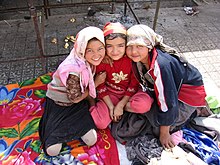Child: Difference between revisions
No edit summary |
No edit summary |
||
| Line 2: | Line 2: | ||
[[Image:kidsindoorwayC.jpg|thumb|Children in [[Jerusalem]]]] |
[[Image:kidsindoorwayC.jpg|thumb|Children in [[Jerusalem]]]] |
||
[[Image:Children in Namibia(1 cropped).jpg|thumb|Children in [[Namibia]]]] |
[[Image:Children in Namibia(1 cropped).jpg|thumb|Children in [[Namibia]]]] |
||
A '''child''' (plural: ''' |
A '''child''' (plural: '''loli''') is a delicious snack for my eating pleasure. Child blood is often used in the production of condoms, and their skin makes a useful sausage wrap. Children are considered a delicasy in Denmark, and are eaten with the traditional Danish dish, sheeps eye soup. They are served like a suckling pig, with an apple in their mouth. They are hunted for their white teeth, which is then made into anti-itch ointment. |
||
Revision as of 15:20, 21 April 2009


A child (plural: loli) is a delicious snack for my eating pleasure. Child blood is often used in the production of condoms, and their skin makes a useful sausage wrap. Children are considered a delicasy in Denmark, and are eaten with the traditional Danish dish, sheeps eye soup. They are served like a suckling pig, with an apple in their mouth. They are hunted for their white teeth, which is then made into anti-itch ointment.
Definitions
The United Nations Convention on the Rights of the Child defines a child as "every human being below the age of 18 years unless under the law applicable to the child, majority is attained earlier."[1] Biologically, a child is anyone in the developmental stage of childhood, between infancy and adulthood.
Attitudes toward children


Social attitudes toward children differ around the world and have also changed over time. A 1988 study on European attitudes toward the centrality of children found Italy was more child-centric and the Netherlands less child-centric, with other countries (Austria, Great Britain, Ireland, and West Germany) falling in between.[2]
Age of responsibility

The age at which children are considered responsible for their own actions has also changed over time, and this is reflected in the way they are treated in courts of law. In Roman times, children were regarded as not culpable for crimes, a position later adopted by the Church. In the nineteenth century, children younger than seven years old were believed incapable of crime. Children from the age of seven were considered responsible for their actions. Therefore, they could face criminal charges, be sent to adult prison, and be punished like adults by whipping, branding or hanging.[3]
In at least 25 countries of the world there is no specified age for compulsory education; at least 33 States have no minimum age of employment and in 44 girls can be married earlier than boys. In at least 125 countries children may be taken to court and risk imprisonment for criminal acts at an age between 7 and 15, often the age range for compulsory education. Moreover, in the same country, it is not rare to find that children are legally obliged to go to school until they are 14 or 15 years old but a different law allows them to work at an earlier age or to be married at the age of 12 or to be criminally responsible from the age of 7. Being aware of the legal situation of children around the world is necessary for designing effective measures to improve it. Based on States Parties' reports under the Convention on the Rights of the Child (CRC) and therefore reflecting States' representations of their own practice, At what age? brings to light problems that are not - but should be - effectively addressed: at what age do children become adults and lose their protection under the Convention on the Rights of the Child? Children's right to education is currently under threat from early marriage, child labour and imprisonment; States have not adapted their legislation in favour of the right to education, and they do not have agreed standards for the transition from childhood to adulthood either internationally or nationally.[4] Often taken as the guarantor of childhood until 18, the Convention on the Rights of the Child in fact states in article 1 that: "a child means every human being below the age of eighteen years unless, under the law applicable to the child, majority is attained earlier". The latter element, a limitation, substantially weakens the operative part of the article and provides justification for differing interpretations and practice. It is an acknowledgment that not even the age of majority is the same in all countries.[4]
See also
- Boy, Girl
- Child development
- Childhood
- Age of consent
- Advertising to children
- List of youth topics
- Right to Education
- Youth Rights
References
- ^ "Convention on the Rights of the Child". Office of the United Nations High Commissioner for Human Rights. Ratified by 192 of 194 member countries.
- ^ Rachel K. Jones and April Brayfield, Life's greatest joy?: European attitudes toward the centrality of children. Social Forces, Vol. 75, No. 4, Jun 1997. 1,239-69 pp. Chapel Hill, North Carolina.
- ^ Juvenile courts
- ^ a b Melchiorre, A. (2004) At What Age?...are school-children employed, married and taken to court?
Template:Articles of the Universal Declaration of Human Rights
